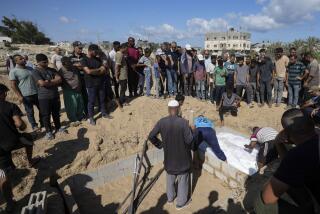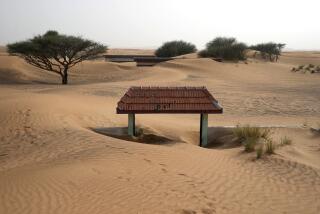Archeologists in Bahrain Race the Bulldozer to Examine Ancient Burial Grounds
- Share via
MANAMA, Bahrain — Archeologists in Bahrain have been racing against time to examine thousands of ancient burial mounds before bulldozers destroy them forever.
Progress has wiped out more than a third of the 80,000 graves, some 4,500 years old, in the largest cemetery of its kind in the world.
Part of what the archeologists have saved will be preserved in a Hall of Graves in Bahrain’s new national museum, due to open in December.
Some graves were in the path of a $1-billion causeway that now links the Gulf island state to Saudi Arabia. Others were buried under a modern housing plan.
Base of Dilmun Empire
Two mounds, one in the oldest style and one later, will be brought intact from the desert to the Hall of Graves. A preserved dabb--a big desert lizard--will guard the tombs.
Bahrain, a palm-covered island made green by fresh water springs, was the base of the ancient Dilmun Empire, whose trade stretched from the Indus Valley in Pakistan to Mesopotamia in present-day Iraq.
Archeologist Bruno Frohlich of the Smithsonian Institute in Washington said that 10 years of research revealed a well-organized Bahraini culture that had grown very wealthy.
Studies on thousands of skeletons revealed that people in Bahrain 4,000 years ago lived longer than contemporaries in other parts of the Middle East, said Frohlich, a biologist.
Signs of Old Age
Some skeletons bore signs of diseases of old age such as arthritis and fluorosis, an ailment caused by excess fluoride.
Few broken bones indicated little warfare, and there were indications of a people cared for and supported by other members of the society, Frohlich said. The resources allotted to grave-building indicated a wealthy society.
Solid bedrock made it difficult to bury the dead underground. Mounds were built in two styles. Crude 4,500-year-old burial chambers of uncut stone are found scattered in dry river beds on high ground.
About 17,000 such mounds were built over a 300-year period. Bronze objects, seals and pottery were placed inside.
Regional Trade
The pottery, of designs common in other parts of the Gulf, indicated active regional trade 4,000 years ago.
Mound styles changed about 2200 BC, and over the next 500 years about 67,000 increasingly sophisticated tombs were built closer to fresh water and settlements.
Frohlich said the change marked a shift in society itself that had become more dependent on land cultivation and trade.
The ancient settlements have not been found, probably because modern villages stand on the same sites.
Stone Chambers
Professional builders prepared the burial mounds, the size depending on the wealth of the client.
A stone chamber, aligned on the rising sun, was surrounded by a wall and the area between the two was filled with sand.
The body was laid in a flexed position with knees drawn under the chin. Objects set alongside it included bronze crafts, carved steatite, baskets of palm leaf and bitumen, sacrificial goats and sheep.
Men’s and women’s graves differed little, and children were buried in small chambers along the mound’s periphery.
Frohlich said research had thrown cold water on a widespread belief that Mesopotamians used Bahrain for burials.
Theory Challenged
The theory held that a small native population in Bahrain would not have needed so many graves.
Mesopotamians considered Bahrain a sacred land, and some experts believed they could have sent their dead to the island for burial. “I have been fighting that theory for years,” said Frohlich, who contends that, on the contrary, not enough graves have been found for the number of people Bahrain could have supported over 800 years.
More to Read
Sign up for Essential California
The most important California stories and recommendations in your inbox every morning.
You may occasionally receive promotional content from the Los Angeles Times.










